Hello fellow readers,
Andrea of Morristown NJ asked what’s going on with her white pines. Seeing evergreens drop needles often triggers concern. It’s kind of like an abundance of hairs in your shower drain.
Evergreen foliage, despite their name, does not live forever. As new growth emerges in the spring, previous year’s growth becomes shaded. During fall, the inner or older needles die and fall off. Pine trees hold their needles typically 2 to 5 years depending on the species. Spruce trees generally hold onto their needles for 5 to 7 years. Hence every autumn some evergreen needles are falling.
Sometimes this natural process goes unnoticed because only the innermost needles are affected. Eastern White Pine (Pinus strobus) are not shy about disrobing. They only hold needles for two years and have an open structure with less growth at the tip of their branches to hide the needles as they undress.
While needle drop is natural (just like some hair loss), stress factors such as drought, herbicide injury, root damage, and insect or disease damage can intensify the loss. Normal needle drop occurs only on the inner needles. If entire branches or new needles at the tips of branches are dying, or if needles turn yellow and drop other times of the year something else is happening. Accessing an arborist is best to advise you on a course of action.
In recent years White Pine Decline has been an issue, though its mysterious what causes it. Authorities have found affected trees have meager root systems likely caused by several soil fungi not yet specifically identified. It’s a slow process and not considered contagious, unlike Pine Wilt caused by a nematode which typically kills a tree in one season. If your tree has Pine Wilt, it should be quickly removed before surrounding ones are impacted. If your tree has White Pine Decline though, there’s no rush to remove it as it won’t infect other trees. However, the only treatment is prevention. Assuring proper irrigation and soil pH (white pines prefer an acidic soil) will help trees fight off the fungi before its impacted.
There are some conifers that shed all their needles every year such as European larch (Larix decidua), Dawn Redwood (Metasequoia glyptostroboides) and Bald Cypress (Taxodium distichum) so don’t think something is wrong when they go bald. In fact, their golden and bronze colors are stunning in the fall and are magnificent additions to the landscape. Besides, baldness can be very attractive. Garden Dilemmas? Askmarystone@gmail.com

Baldness can be very attractive. Thanks for sporting your handsome heads boys. (No need to cap it dear Curt. Other than for sun protection that is ;^)…)





